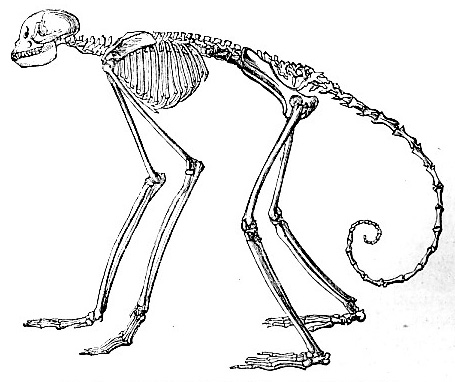The cervical region is relatively more elongated than in man in Hylobates, Cynocephalus, and Ateles. The atlas is very man-like in Troglodyres and Simia, except that its transverse process is rather smaller and shorter relatively, and more curved dorsally. Except in Ateles and the Simiinae, it is almost always perforated by the vertebral artery, instead of being merely grooved by it. In Cynocephalus the atlas is exceedingly massive, and may, by very rare exception, develop a spinous process. The spines of the cervical vertebrae do not bifurcate beyond the second, and generally the spine of the seventh vertebra is the longest, at least with the exception of that of the axis. In the gorilla, and orang, however, the spines of the third, fourth, fifth, and sixth vertebrae are exceedingly elongated and longer than that of the seventh. The cervical neural laminae are wider antero-posteriorly, the vertebral column being supposed horizontal, in Hylobates and Ateles than in other forms. Beneath the anterior articular process (prezygopophysis) a marked prominence -- the metapophysis -- may be developed, and is particularly conspicuous in Ateles. The costal plate of the esixth cervical is almost always larger than the homologous part in the other cervicals; but it predominates least in the chimpanzee and Nyctipithecus. The length of each centrum, compared with its breadth, is already greater in Troglodytes and Simia than in man. In others the dimensions are about equal, except that in Cynocephalus, Ateles, and Mycetes the length slightly exceeds the breadth.
The dorsal vertebrae vary in number from eleven, as sometimes in Cercopithecus and Macacus, to fourteen, as sometimes in Hybobates, or even to fifteen, as in Nyctipithecus. In the Cebidae, above the Hapalinae, the number rarely falls below thirteen. In the orang the number is, as in man, twelve; in troglodytes it is thirteen. The proportion of this region does not increase regularly with the number of its vertebreae. It attains it greatest relative length in Ateles, where it is over nine-twentieths of the total length of the spine without the tail; while in Nyctipithecus it is relatively shorter than in Troglodytes or Simia. The increase in transverse diameter of the bodies of the vertebrae, as we proceed from before backwards, is exceptionally great in Hylobates and Cynocephalus. The lumbar region contains from four to seven vertebrae. In the Simiinae and Cebinae there are four or five, though in Cebus the number is often six. Its relative length is greatest in Nyctipithecus, Chrysothrix, the Semnopithecinae, and Cynocephalus. It is least in the Simiinae, and Ateles.
The number of dorsal and lumbar vertebrae, taken together, is seventeen in Troglodytes and Simia, eighteen (mostly) in Ateles and Hylobates, and nineteen in the rest. In most forms the dorsal and lumbar regions are about equal in length, but the lumbar region is the shorter in the Simiinoe, and less than half the length of the dorsal in the gorilla.
The lumbar, spinous processes are vertical, or project backwards in the Simiinae and in Ateles; in the other forms they project strongly forwards, especially in the lower Cebidae. The lumbar transverse processes always project outwards, more or less at right angle to the axis of the spine, or else forwards. In the Simiinae and Ateles they are never inclined ventrally, but in some of the lower Simiadae they begin to be so; in the lower Cebicae they are so very decidedly. Only in Troglodytes and Simia are they inclined somewhat dorsally. In the last two general the lumbar vertebrae are broader than their length; in most other forms length is in excess. The length of the individual lumbar vertebrae, compared with the dorsal (e.g., the longest lumbar with the ninth dorsal), is greatest in the lower Cebidae, rather less in the lower Simiadae, and least in the Simiinae.
The sacrum attains its greatest absolute length in the gorilla, but is relatively longer than in man in all the Simiinae. Of all the inferior apes, Hylobates has the relatively longest sacrum. The number of vertebrae included in the sacrum varies more or less with age. In the apes below the Simiinae there are generally only two or three sacral vertebrae. In Ateles, Hylobates, and Brachyurus, there may be four; while in the Simiinae there are always five, and sometimes six sacral vertebrae.
In most apes the sacrum and lumbar vertebrae appear to lie in one slightly curved line. Troglodytes presents in this respect a great contrast to the human structure. In Simia the sacro-vertberal angle is rather more marked; but sometimes in Cynocephalus it is so much so as almost to rival that of man. The same may be said of the concavity of the anterior surface of the sacrum. It is most marked in the Cynocephali, and is more so in Simia than in Troglodytes.
The sacrum gradually tapers posteriorly in Troglodytes and Simia, and more or less so in Gylobates. In the other Simiadae, however, the sacrum is very wide at its anterior end, and it then very rapidly contracts backwards, so that the transverse diameter of the third sacral vertebra is very much narrower than that of the first. In the Cebidae generally, and especially in Ateles, the contraction is not so marked.
Read the rest of this article:
Ape - Table of Contents
